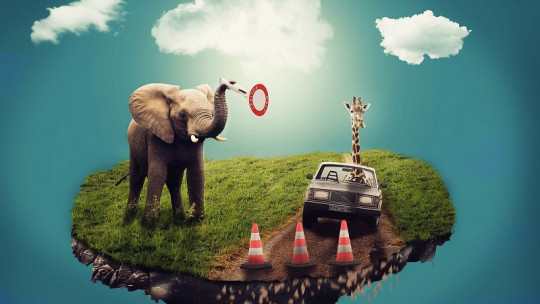Everyone dreams. Human beings spend a third of their lives sleeping and, of that third part, at least another third spends dreaming, thus for a large part of our lives we live in an authentic dream world.
Both the question of why we dream and the interpretation of dreams They have been a fascinating topic for humanity since ancient times, and have always been surrounded by an atmosphere of mystery, since a definitive theory about this creative process of our subconscious has not yet been reached.
The first interpretations of dreams in history
In Mesopotamia, the Babylonians believed that dreams considered “good” were sent by the gods and “bad” dreams were sent by demons. They had a goddess of dreams called Mamu to whom the priests prayed and tried to please to prevent bad dreams from coming true.
The Assyrians also interpreted dreams as signs. They believed that bad dreams were a warning and required action to correct the problem that had appeared in the dream. They thought that the person who had a bad dream should follow whatever advice they interpreted from the dream.
On the other hand, the ancient Egyptians believed that the gods revealed themselves in their dreams. They thought that these visions cause real things that cannot be controlled or interpreted by the consenter. They wrote down their dreams on papyrus and differentiated between three types of dream experience: those in which the gods demand an act on the part of the dreamer, those that contain warnings or revelations, and dreams in which they were reached through a ritual. The three types of dreams served as a way to know the messages of the gods, like oracles.
Since the best way to receive divine revelation was through dreams, the Egyptians induced sleep in people who They asked for answers from the gods. They traveled to shrines or sacred places to lie down, sleep and dream in the hope of receiving advice, healing or consolation from the gods.
Why we dream: approaches from psychology
Psychology is no stranger to this interest and has approached the world of dreams from various disciplines (anthropology, neuroscience, psychology, literature…), although the reasons why we dream remain mysterious. There are a number of interesting hypotheses and theories and relevant that try to explain why we dream.
1. Satisfaction of desires
One of the first and main researchers of dreams was Sigmund Freud , who analyzed several patients and even used his own dreams as examples to demonstrate his theory. He proposed that dreams represent the dreamer’s fulfillment of a wish whether real or symbolic, including nightmares.
According to Freud, dreams are considered a collection of images from our conscious lives that have symbolic meanings. related to our subconscious desires.
For Sigmund Freud, all dreams are interpretable and what is dreamed does not have to be a totally real wish, but rather a symbol of something we want to happen, which is why he proposed that all dreams are interpretable.
2. Side effect
J. Allan Hobson and Robert McClarley in 1977 developed the activation-synthesis theory. According to this theory, in the REM phase of sleep, the brain circuits are activated, causing the areas of the limbic system (including the amygdala and hippocampus) involved in emotions, sensations and memories to become active.
The brain tries to interpret these signals and dreams are the subjective interpretation of the signal generated by the brain while we sleep. However, the theory does not imply that dreams are meaningless but suggests that they are our most creative state of consciousness.
3. Keep the brain active
Psychiatrist Jie Zhang proposed the theory of continuous activation of dreams, with dreams being the result of our brain’s constant need to create and consolidate long-term memories for proper functioning.
When we are asleep, our brain automatically triggers the generation of data from memory stores and this data is not displayed in the form of feelings or thoughts but we experience them in our dreams. According to this theory, our dreams would be like a kind of random “screensaver” that our brain starts so as not to turn off completely.
4. Forget: mental cleansing
Neuroscientist Francis Crick together with the mathematician Graeme Mitchiso in 1983, developed the theory of reversal learning.
The theory indicates that we dream to get rid of connections and associations accumulated in our brain that we do not need to store. Therefore, we dream to forget as a kind of mental escape route, as if dreaming were a method of garbage collection or mental cleaning.
5. Consolidation of learning
At the end of the 19th century, the German psychologist Hermann Ebbinghaus, after various experiments and observations, indicated that dreams serve to consolidate what we have learned during the day. However, this theory was discarded by the scientific community since they considered that the brain is not active while we sleep.
In the 1950s, Aserinsky and Nathaniel Klietman verified in several experiments that the brain continues working while we sleep and is dedicated to process everything you have acquired during the day. Review recently formed memories, analyze them and discard those that are irrelevant, enhancing and qualifying those that may be useful. However, how the brain performs this task remains a mystery.
6. Defense mechanism
The dream could be related to a defense mechanism. When we dream, the brain behaves in the same way as when we are awake, although the dopamine system associated with movement is not active. Therefore, such tonic immobility or playing dead could be considered a defense mechanism.
7. Rehearse
Dreams commonly include threatening and dangerous situations. The Finnish philosopher and pseudoscientist Antti Revonusuo suggested the theory of primitive instinct essay by which the function of dreams would be simulate threatening events or situations and rehearse the perception of said threats in order to avoid them.
This theory maintains that the content of the dream has a lot of meaning for its purpose. Furthermore, not all dreams are threatening or unpleasant, they can also serve as practice or rehearsal for other situations.
8. Troubleshooting
Deirdre Barret suggests that dreams are a way to solve problems. Author John Steinbeck called this the “Sleep Committee.” As if it were a theater, lacking the rules of conventional logic and the restrictions of reality, the mind can create all kinds of dreams of scenarios solving problems more effectively than when we are awake. This is why we tend to think that the best solution to a problem is achieved after we have slept.
9. Dream Darwinism
Psychologist Mark Blechner states that dreams function as a natural selection of ideas that would serve to generate new ideas. Some research suggests that in the various situations we dream about, we try to select the most useful reaction to successfully deal with those situations.
Dreams introduce useful variations to psychic life and internal narratives they would produce variations to generate new types of thinking, imagination, self-awareness and other psychic functions
10. Processing painful emotions
Lastly, dreams could be considered as a kind of evolutionary therapy in which in dreams we do not select the best emotion or behavior but rather they serve as a relief through the association of some emotions with symbols that appear in dreams.
Conclusion
These are just some of the most prominent explanations, as technology and research advance our ability to understand the brain will increase and we may one day discover the definitive reason why we dream. Today, despite everything we know about sleep physiology, dream thoughts remain an enigmatic and controversial field.









